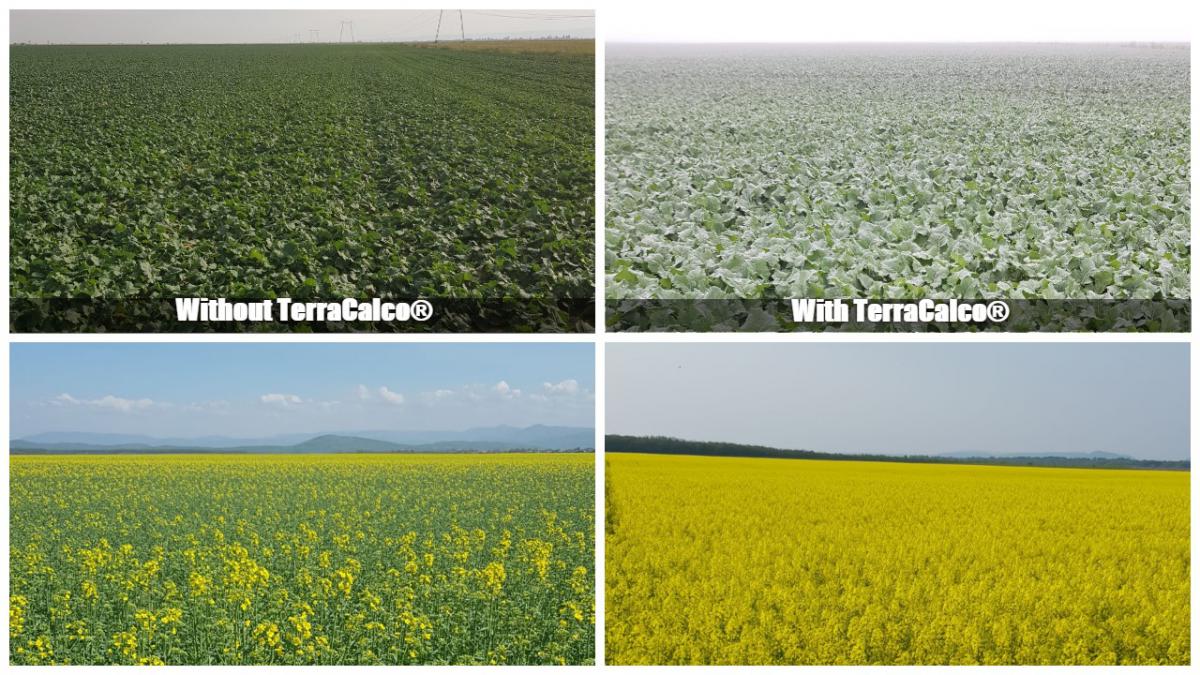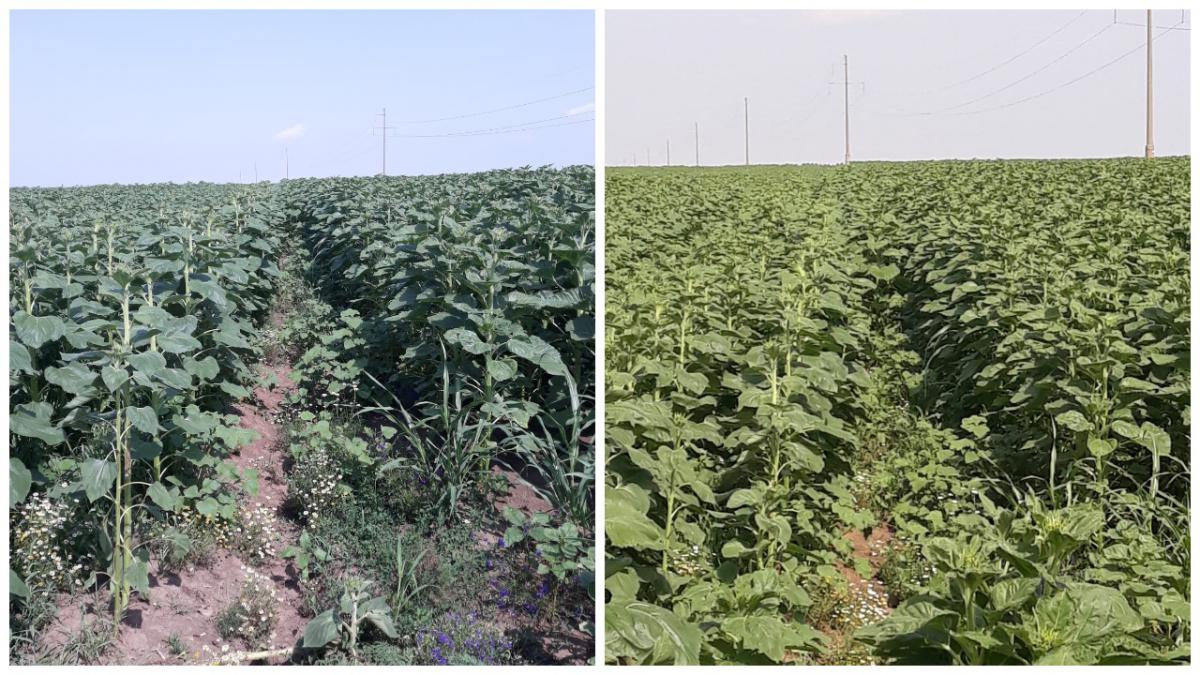THEY BET ON CALCIUM AND THEY WON! HERE IS THE POSITIVE EXPERIENCE OF 3 FARMERS, AND THE CHEMICAL EXPLANATION BEHIND THEIR SUCCESS:
Tagu Rosu Farm – Kovacs Ede – 1000 ha, Romania
“I used TerraCalco® 95 last summer for rapeseed, 20 days before sowing, a dose of 1 to/ha. Practically, this ton of TerraCalco® has replaced 5 tons of carbonate, sparing us of multiple operations, difficult spreading, lack of homogeneity on soil, etc. I can say that after so many years of using each time 5 to/carbonate per ha, now, with TerraCalco® 95, when I am amending I feel like a king. Besides this aspect, I noticed that it went into reaction much faster and this was visible on the plants. There was a difference of minimum 20 cm between the rapeseed where I used it, and where I didn’t. I compared with the 5 to of carbonate that I used on another parcel, just to check the differences, and I can honestly say that the TerraCalco® effect was much more visible. You can also notice it in the pictures. I plan to use it on the entire surface now because I have seen that it works and the quality/price ratio is ok!”

Nicusor Carpen – 530 ha
“I used it in the fall of 2017, then I scarified. I used 850 kg/ha, 120 ha, and I want to tell you that it’s really easy to work with it, compared to classical amendments. Very easy. I did not reach the scale test yet, but I can definitely say 2 things: the crops look great and the soil is much more aerated. I will continue to use TerraCalco® and I strongly recommend it!”
Gorgicze Stefan, Arad, Romania
“I used it in the spring for sunflower. The results have been amazing. Look at the pictures, on the right we used TerraCalco®, 500 kg/ha and on the left we didn’t. Everyone can say whatever they want, but for me, the difference is clear. I don’t have an extremely acid soil, but still you can see that TerraCalco® has unblocked the nutrients from the soil”.

WHY TERRACALCO®? THE CHEMICAL EXPLANATION
- Demian Viorel – Independent agricultural consultant: “CALCIUM IS LIKE A REFEREE ON THE MACRONUTRIENTS’ FOOTBALL MATCH”
- What should a farmer know about the soil he is working on?
First of all, what kind of pH the soil has: basic or acid?
- Why?
The behavior of the soil towards the plants and fertilization and amending scheme is VERY DIFFERENT depending on this pH. If we know the soil type, then the question is what do we know about the acid soil?
- So let’s talk about the acid soil:
The acid soil is considered eligible for amending when the pH drops under 5,80 – 6
Acid soils always have a Calcium deficiency, and this deficiency is a permanent concern and priority for farmers.
- Why is Calcium a priority?
First of all, Calcium has the role of a NUTRIENT, then of an AMENDMENT. THE NUTRIENT ROLE consists in the fact that it is on the third place considering the number of atoms extracted by the plants, after Nitrogen-N and Potassium-K, but it could also be on the first position in atomic mass, in certain situations. So practically, it is used in the production process and exported with the production itself.
Corn for instance uses 8-9 kg of Ca per ton of grains (more than phosphorus).
THE AMENDMENT ROLE consists in the fact that it is the « carrier » of hydroxyl anions OH - - this anion that is lacking in acidic soils and that makes the difference in pH.
A little quantity of calcium cation in acidic soils will have an effect on the potassium cation which is usually blocked when the pH decreases too much. We will not go into explanatory details of this phenomena, but the important thing to know is that extreme levels of pH block the main macronutrients, such as: phosphorus, potassium and the NITRIC ions, by blocking the nitrification reaction, because nitrification stops at a pH<5 and the ammoniacal nitrogen, which is not always used by some plants, increases. When farmers use fertilizers that have the nitrogen in an ammoniacal form on a very acid soil, they might actually not give any nitrogen to those plants.
In fact, we are talking about fertilizers that should be chosen based on the pH of the soil, and so on the calcium content in the soil- fact which is less known in production and even neglected sometimes in the fertilizing technology. For example: slow release urea is excluded from fertilization on such very acid and unamended soils.
Calcium is like a REFERREE on the Macronutrients football match. Imagine a football match without a referee, in the same way we can refer to a soil without calcium.
Let’s consider a comparative analysis between TerraCalco® versus another product on the market:
CHEMICAL ANALYSIS ON TERRACALCO® versus another superior amending product referred to as “X”
- TERRACALCO® Superior amending product “X”
Both products are dissolved in rain water:
Vol: 50 ml TerraCalco + 200 ml water 50ml + 200ml water
-pH=12,51 - pH=9,12
-Ca>400 mg/l - Ca<225mg/l
-Calcium hardness>600 mg/l - Calcium hardness >500mg/l
Notable difference in the pH of the two amending products.
TerraCalco® is a product highly superior to other products available on the market, having a HIGH FERTILIZING POWER IN A LOW VOLUME.
TerraCalco® is a calcium oxide CaO and has an amendment neutralizing power of 170%, the highest neutralizing power available on the local market. Not to be confused with the calcium content, which is 95%.
For instance, calcium carbonate with nitrogen residues from factories has an amendment neutralizing power of 50-85% and a water content of up to 30%.
Correcting the pH:
CaO +H2O---------HEAT DISCHARGING-----àCa(OH)2-àCa2+ +2OH-
Calcium OXIDE Calcium Hydroxide
OH - - The hydroxides released in the soil solution are anions that correct the soil reaction, and the calcium cations are carriers of anions, without this pair we cannot talk about amending!”
